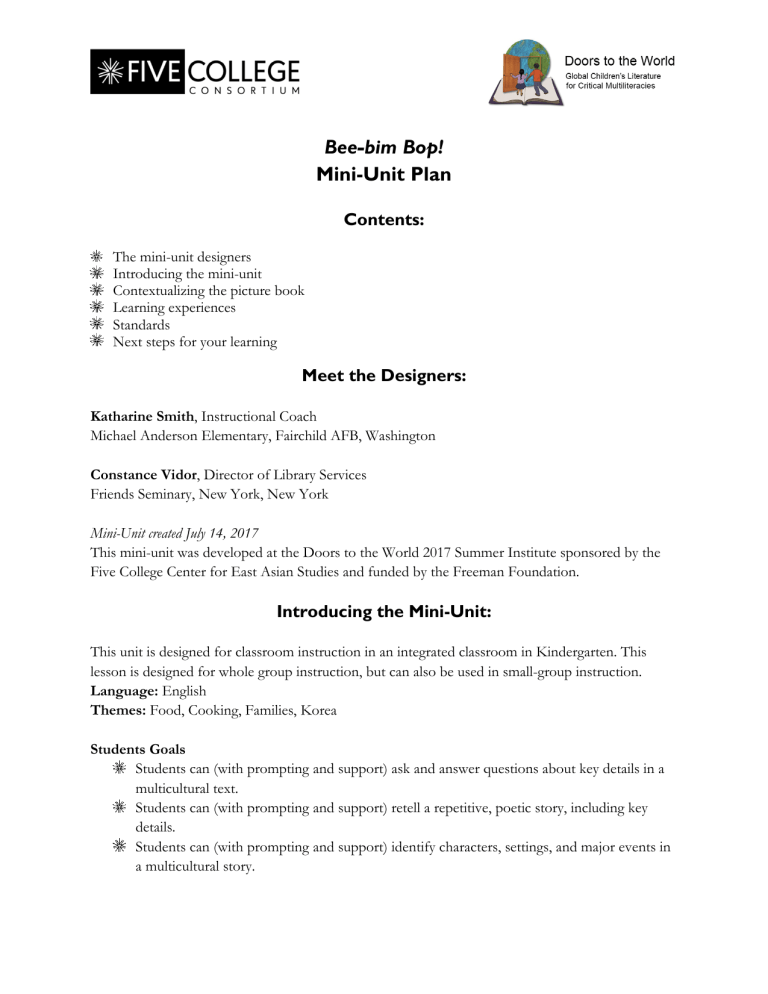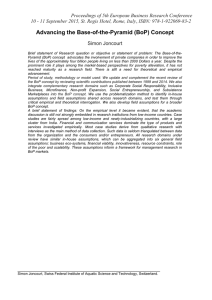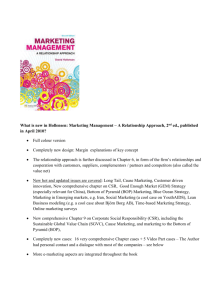Bee-bim Bop! Mini-Unit Plan for Kindergarten
advertisement

Bee-bim Bop! Mini-Unit Plan Contents: The mini-unit designers Introducing the mini-unit Contextualizing the picture book Learning experiences Standards Next steps for your learning Meet the Designers: Katharine Smith, Instructional Coach Michael Anderson Elementary, Fairchild AFB, Washington Constance Vidor, Director of Library Services Friends Seminary, New York, New York Mini-Unit created July 14, 2017 This mini-unit was developed at the Doors to the World 2017 Summer Institute sponsored by the Five College Center for East Asian Studies and funded by the Freeman Foundation. Introducing the Mini-Unit: This unit is designed for classroom instruction in an integrated classroom in Kindergarten. This lesson is designed for whole group instruction, but can also be used in small-group instruction. Language: English Themes: Food, Cooking, Families, Korea Students Goals Students can (with prompting and support) ask and answer questions about key details in a multicultural text. Students can (with prompting and support) retell a repetitive, poetic story, including key details. Students can (with prompting and support) identify characters, settings, and major events in a multicultural story. Students (with prompting and support) describe and analyze the relationship between illustrations and the story in which they appear. Contextualizing the Picture Book: Title: Bee-bim Bop! Author: Linda Sue Park Illustrator: Ho Baek Lee Publisher: HMH Books for Young Readers, 2005 Genres: Poetry and Realistic Fiction Summary: The text contains the story of a young child who is preparing bee-bim bop with her mother for a family dinner. Bee-bim bop is a traditional Korean dish made of rice, vegetables, beef, spices, and egg. The child helps the mother shop, prepare ingredients, chop the vegetables, and set the table. The text ends with the family enjoying the dish. Rhyming, repetition, and onomatopoeia are utilized. About the author and illustrator: Linda Sue Park is a Korean American author from New York. Her book, A Single Shard, won the 2002 Newbery Award. http://www.lindasuepark.com/bio/biography.html Ho Baek Lee is a Korean illustrator based in Seoul, Korea. He contributed to While We Were Out and The Stronger Rooster. Sources of inspirations for the author: Linda Sue Park makes bee-bim bop with her nephew and niece. According to Linda Sue Park, bee-bim bop is a favorite Korean meal. Geographical Region/Time Period: This story is present day. The geographical region is not specified. Cultural Themes: Family, food. Media of Illustrations: Watercolor. Awards and other recognitions: New York Public Library, 100 Titles for Reading and Sharing Bank Street Best Children’s Books of the Year Analyzing the Picture Book Every teacher has his or her own ways of sharing books with children. The questions and prompts below offer some ways to help students both enjoy and analyze some of the many components of this story—literary, artistic, social, geographic, and emotional. What do you see happening on the front cover? Encourage students to notice all the characters—the child, the dog, and the adult; consider asking students to guess who that adult might be. Encourage students to notice the different kinds of actions as well as different kinds of food on the front cover. There is an adult with a child and a dog. The parent’s face is not on the cover as the illustration bleeds off the page. The child is helping the adult set the table by carrying utensils and chopsticks to place on the table. The dog appears to be pushing the dog bowl close to the table as if it wants to share the family meal. There is rice, salt and pepper shakers, and two dishes of food separate from the rice. What do you think Bee-bim bop means? This could have something to do with food since there are different foods on the table. It could be in reference to a family gathering or holiday. What do you think might happen in this book? Encourage students to be specific, to move from “they will eat something” to responses that imagine individual as well as group actions, and that include a variety of possible activities related to food, cooking, eating, and family life. The family could be preparing a meal. The family could be celebrating a holiday (since food is associated with some holidays). (Turn page to show the half-title page, which shows the plates of food under the title.) Students, do you want to revise your guess about what bee-bim bop is? (Students should understand that bee-bim bop is the name of this dish.) Bee-bim bop could be the dish that the family makes. Let’s look at our dedication page. It reads: “To Jackson and Margaret” [and] “For everyone who loves Korean food.” Who might Jackson and Margaret be? L.S.P (Linda Sue Park) could have written the book for her children (Jackson and Margaret). Or she could have written the book to two people in her family. How about “Korean food”? Has anyone eaten Korean food? If some students in the class have direct connections or experience with Korea, their responses will help the rest of the students to learn that Korean food is food from the country Korea. Although Korean food has origins in Korea, people all over the world make, eat, and enjoy Korean food. Let’s look at this map of the world. (Point out Korea on a world map.) Does anyone know someone from Korea? Again, if some students have familiarity with Korea, they can help their classmates understand that Korea is a country, and that some families/individuals who may have once lived in Korea now live in the United States. If “Korea” is a new concept/word for the entire class, then the teacher may explain that there are many different countries in the world, and people in every country have favorite ways of cooking. Let’s enjoy the story now. The family is going to have a favorite kind of food from Korea called bee-bim bop. Can you say that? Let’s practice saying it together. (Help students to chant bee-bim bop all together in rhythm.) Every time I signal you, you can all join in on the bee-bim bop. (Read story aloud for the immersive pleasure of it, having students join in on the refrain “bee-bim bop” up through page 20.) Now let’s pause and take a closer look. Who are the characters you’ve seen so far? (Students may notice the child, the dog and the adult.) How does the artist portray the different characters? (Students may notice that the mother’s head is not included in the illustrations until after page 20. Teacher may want to ask students why they think the illustrator made that choice.) I see the mama and child. On the first spread, I can see the mama and child completely. But as the text continues, the mama’s head is not in the illustrations. The child is completely shown in all the illustrations, which makes me focus on the child in this text. The mama and child wear a slipper type of shoe. The mama does the cooking, while the child helps prepare things like onion. How do the illustrations make you feel? What emotions do you see in the characters and how can you tell what they might be feeling? The child has a smile and appears happy in many of the illustrations. The dog seems excited as it jumps around and has some drool flying from its mouth. What do you think might happen next in the story? What other characters might we meet? What do you think they might do or say? I think we will meet more family members. There is a lot of food being prepared, so there could be more family coming to share the meal such as aunts, uncles, grandparents, and possibly neighbors. I think the family will be appreciative of the food. Now let’s finish reading the story! (Continue reading, encouraging students to join in on the repeated words “bee-bim bop!”) Let’s look at this page (page 24). How are the people in this family different from each other, and how are they the same as each other? Are they all dressed the same? What do you think they might be feeling inside? (Students may notice the Grandmother wearing a traditional Korean gown as a point of contrast with the clothing of the rest of the family; they may notice details of hairstyles and ages. Encourage students to notice the peaceful expressions on the faces of the baby, the father, the Grandmother, and the dog. Help students to consider that similarities and differences may be external, such as the clothing, or internal, such as the feelings.) I see the grandmother wearing traditional Korean clothing. Everyone mixes their bee-bim bop. Some family members use a spoon, and some family members use chopsticks to eat the food. Who is telling this story? How do you know? To whom is she speaking? (Help students get a sense of the concept of “narrator.”) Do you know any other stories where a character in the story is the one telling it? Owl Moon by Jane Yolen is one example of a picture book narrated by the child character in the story. The child is telling the story. Who is the “bossy” person in this book? (This might be a way of beginning to explore issues of power with very young children.) Who “gives orders” and who “follows orders?” (Help students to explore the dynamic of the child telling the mother what to do to shop and prepare the food.) Do you ever tell your parents what to do? The child tells the mama to hurry, hurry. But the child also recognizes that she needs to mop the floor and apologizes to the parent. What other stories about food do you know? What other stories about families? (See section on Juxtaposing Texts.) What kind (genre) of story is this? It is a fantasy or a realistic story? How do you know that? Connecting Picture Book to Family, Community and Current Events/People: Child readers may be able to connect this story to their own family because some children may help make meals at home with a parent or family member. Some students may have helped make meals in a preschool setting. Some children may connect with making meals at friends’ homes or at a community center. For some students, making meals at home and eating with family is typical, but for other students, making meals and eating meals with family is a rare occurrence. Mealtimes in any given home reflect the wide diversity of family structures and habits. It is important to frame discussions that touch on family dynamics with a commitment to respect for all kinds of family structures. How is this family the same and/or different from your family? (See “Hook” activity.) What are some favorite meals you share with your family? (Students may mention eating at home, eating out, going on a picnic, or enjoying different kinds of food. All experiences should be validated and respected.) Where does your family go to get food? (Students may mention grocery store, a community center, or a farmer’s market.) Invite students and their caregivers or families to write down a favorite recipe and contribute to a class collection of recipes. Recipes may be written in the family’s home language and translations provided as possible. Young children may contribute drawings; older children may help with the writing. The resulting collection can be displayed and shared among classroom families. Juxtaposing Texts: Other books that will support the themes of food and families linked with different cultural contexts are listed below. Students may enjoy comparing and contrasting these different stories. Reading a variety of books that are connected by theme will help students develop confidence with vocabulary, analysis, and observation. In order to help children develop their concept of genre, we have included both realistic and nonrealistic narratives. Dim Sum for Everyone by Grace Lin (2014) A child describes the various little dishes of dim sum that she and her family enjoy on a visit to a restaurant in Chinatown. (Family, Food, East Asian culture) The Ugly Vegetables by Grace Lin (1999) A little girl thinks her mother's garden is the ugliest in the neighborhood until she discovers that even though flowers might look and smell pretty, Chinese vegetable soup smells best of all. Includes a recipe. The Legend of the Bitter Gourd (2003) Filipino story about a pale and bland-tasting vegetable named Ampalaya. He is envious of the taste, color and beauty of other vegetables in Sariwa town. Because of his greediness, he steals the sweetness of Kalabasa, the sourness of Kamatis, the spice of Luya and the complexion of Labanos. He also takes the purple color of Talong and the green cheeks of Mustasa. Available online from the International Children’s Digital Library (http://en.childrenslibrary.org/). How My Parents Learned to Eat by Allen Say (1984) An American sailor courts a Japanese girl and each tries, in secret, to learn the other’s way of eating. Boy Dumplings by Ying Chang Compestine (2016) When a hungry ghost threatens to gobble up a plump little boy, the boy tricks the ghost by convincing him to prepare an elaborate recipe first. Includes a cultural note on the Ghost Festival and a recipe for dumplings. Growing Up with Tamales by Gwendolyn Zepeda (2008) Six-year-old Ana looks forward to growing older and being allowed more responsibility in making the tamales for the family's Christmas celebrations. The Princess of Borscht by Leda Schubert (2008) Ruthie’s grandmother, in the hospital with pneumonia, says she needs homemade borscht by five o'clock and young Ruthie, with the help of her neighbors, tries to make some—without the secret recipe. Fairy Tale Feasts: A Literary Cookbook for Young Readers and Eaters by Jane Yolen (2009) This collection of fairy tales retold by Jane Yolen emphasizes the role of food in each story. Paired with lush illustrations and a recipe, stories include: The Magic Pot of Porridge; The Brewery of Eggshells; Diamonds and Toads; The Runaway Pancake; Little Red Riding Hood; The Magic Cave; The Fox and the Grapes; The Stolen Bread Smells; Brer Rabbit; Share Crops; Stone Soup; The Little Mermaid; Hodja Borrows a Pot; The Three Lemons; The Great Turnip; Jack and the Beanstalk; Cinderella; The Magic Pear Tree; Snow White; Seven Hills of Sweet. Learning Experiences: Learning Experience Design #1: Hook Learning Experience, 30-40 minutes The purpose of this lesson is to engage the students’ background knowledge about the traditions of making a meal or eating a meal with family. Show students images of children preparing meals with family. https://drive.google.com/file/d/0B30BasfPJaGlNDhTRkp2WXV3Nzg/view?usp=sharing Alternatively, offer students opportunities to look at images of children sharing food with friends at school. Ask students: What is going on in this picture? What do you see that makes you say that? What else can you find? Show students these four images of children eating at table with family. https://drive.google.com/file/d/0B30BasfPJaGlMTBwRHdvNGdYT2c/view?usp=sharing Ask students: What is going on in this picture? What do you see that makes you say that? What else can you find? What feelings do you see in these images? Ask students: What does your family or group of friends look like when they are eating or making a meal together? Have students draw a colorful picture and then write about what they drew. Students share their drawings with a partner or small group. Returning to the whole group, students can share about what their partners showed and stated. Learning Experience #2: Critically Analyze, 20-30 minutes The purpose of this lesson is to provide students the opportunity to describe and analyze feelings and senses about the illustrations/text in the book. Cut the spine off a copy Bee-bim Bop. Hang a selection of two-page spreads on the walls of the classroom. (Or use photocopies of the two-page spreads to hang.) Tell students to look carefully at the pictures and think about what kinds of emotions and feelings are shown on the pages. Tell students: “I’m going to select 2-3 students to choose an illustration that shows surprise.” Practice with students a pantomime of what surprise looks like. Give those 2-3 students an “emotion card”, picturing a surprise emoji. Give all the students about 20 seconds to look around and decide which illustration they would choose, but only the 2-3 students with the emotion card should get up and sit by their choice. Then repeat the same directions for other feelings (either emotional or physical): calm, stinging (page 12-13, in which the little girl is rubbing her eyes while her mother chops scallions), happy, excited. Provide emotion cards of each of the feelings. When saying the key word to the students, check for understanding by asking students to say what the word means or show in pantomime what that word meaning suggests. Make sure students understand that they may sit anywhere they choose as long as they have a reason for their choice. Students may choose illustrations that other students have already chosen for a different word. When all students have had a chance to sit by an illustration, ask them to explain their choice by pointing to details in the illustration. Learning Experience #3: Readers Theatre, 20-30 minutes The purpose of this lesson is to provide students the opportunity to use repetition, song, and movement to act out the joy of making a meal. Readers Theatre: The students participate in a Readers Theatre, which emphasizes song and repetition. As a class, students practice repeating the choral piece “Hungry, hungry, hungry for some bee-bim bop! Add a body motion for hungry (such as a tummy rub), and have students practice the choral piece with the movement. Group students in 5 groups to practice small group parts. The teacher helps students practice their parts (and body motions if possible). Group 1: “Hurry, mama, hurry gotta shop, shop, shop” (push a cart) Group 2: “Hurry, mama, hurry gotta flip, flip, flop” (flip imaginary spatula up and down) Group 3: “Hurry, mama, hurry gotta pop, pop, pop” (hop up and down) Group 4: “Hurry mama, hurry gotta chop, chop, chop (chopping motion with hands) Group 5: “Hurry mama, hurry gotta mop, mop, mop (mopping motion with hands and arms) Practice the Readers Theatre as a whole class: Whole class: Hungry, hungry, hungry for some bee-bim bop Small group 1 Whole class: Hungry, hungry, hungry for some bee-bim bop Small group 2 Whole class: Hungry, hungry, hungry for some bee-bim bop Small group 3 Whole class: Hungry, hungry, hungry for some bee-bim bop Small group 4 Whole class: Hungry, hungry, hungry for some bee-bim bop Small group 5 Whole class: Hungry, hungry, hungry for some bee-bim bop This learning experience is multi-modal and helps students to understand the fun the child in the story has while making bee-bim bop with her mother. Alternatively, students may improvise their own Readers Theatre performances by working in small groups with puppets or with their own bodies to act out a favorite page or scene from this book. Summative Learning Experience: After exploring Bee-bim Bop through analysis, Readers Theatre, and other learning experiences described above, students will be prepared to create their own stories about food and family. The following prompts are designed to help students to do this in various ways: Bee-bim Bop is a story about a family’s favorite food. Can you write a story about a favorite food in your family? If students are not yet skilled in writing, teacher may have students dictate the story into a digital recorder. What are the ingredients? How do you make it? How does it taste? What does it look like? How does your family share food at meals? Fold a piece of paper in thirds. In the first third, write and/or draw the shopping. In the second third, write and/or draw the preparation. In the last section, write and/or draw your family sharing this food. Look at the list of words used for the feeling-matching lesson (in which students chose illustrations that they thought showed calm, stinging, happy, excited, etc.) and see if you can find a way, using either words or drawing, to show one of those feelings in each section of your story. Take some photographs of your family preparing and sharing food at home. Write captions for the photographs and create an e-book to share with a classmate. Students may have read several folktales or other non-realistic stories about food. Choose a favorite food and act out with a partner one of the following non-realistic scenarios: What if your favorite food grew to an enormous size? How would you try to eat it? What would you do with it? Imagine one of the ingredients of bee-bim bop is a character. How would the ingredient tell the story from their point of view? Materials needed for these activities include paper, crayons or markers, pencils, pens, and/or a computer for digital recording and manipulating images and texts for the e-book. For young children who may still be learning digital skills, parent volunteers will be useful for helping create the e-books. Creating Additional Multimodal and Interdisciplinary Opportunities: Teachers may wish to collaborate with the music teacher to teach students some songs about food such as On Top of Spaghetti, Sandwiches are Beautiful, Hot Cross Buns, Apples and Bananas, and C is for Cookie. Bee bim Bop is written in a bouncy rhythm that is similar to the rhythm of nursery rhymes. Share the book Korean Nursery Rhymes: Land of Goblins and other Favorite Songs and Rhymes by Danielle Wright. Play the accompanying CD for the students so they hear the sound of the music and the language. Artists throughout history have used food to inspire their work. Show students examples of paintings, such as: still life with fruit by Cezanne; The Peasant Wedding Feast by Pieter Breughel; Vertumnus by Archimbaldo; Mexico’s Night of the Radishes; or surreal portrayals of food. Provide materials and opportunities for children to experiment with and create their own food-inspired art. The Grandmother in Bee bim-Bop is eating with chopsticks. Bring in chopsticks for all the students to handle and use for eating a snack. Invite parents to come in and do some cooking with the class. Reach out to parents who may have expertise in cuisines from different parts of the world. Share songs and nursery rhymes in Korean with students. The website Mama Lisa’s World of International Music and Culture includes many Korean nursery rhymes in both English and hangul, along with printed music and recordings. Standards: CCSS RL.K.1 With prompting and support, ask and answer questions about key details in a text. CCSS RL.K.2 With prompting and support, retell familiar stories, including key details. CCSS RL.K.3 With prompting and support, identify characters, settings, and major events in story. CCSS RL.K.7 With prompting and support, describe the relationship between illustrations and the story in which they appear. Next Steps for Your Learning: A focus on food and eating reminds us as adults that many children come to school hungry and that not all children have joyful experiences around food in their families. How can a teacher use a text like Bee-bim Bop in a way that is inclusive for children whose food situation is less secure? Is this a book only for classrooms where there is a certain level of food security? For more privileged groups, when and how do we introduce the notion of food insecurity? How old should children be before they participate in a canned food drive? Consider making bee-bim bop in the classroom for students to taste and eat: http://singdanceplaylearn.com/kid-friendly-recipes/bee-bim-bop/ Consider watching the Between the Lions connection to Bee-bim Bop: http://resourcesforearlylearning.org/parents/activity/1836/ Consider using Chicken Soup with Rice by Maurice Sendak as a follow up for more opportunities to practice repetition reading with the topic of food woven into the text: https://www.youtube.com/watch?v=sNBzJlpwChU https://www.amazon.com/Chicken-Soup-Rice-Book-Months/dp/006443253X



